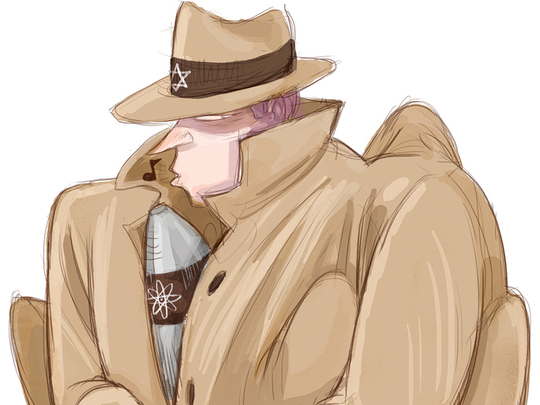
Iran may be following the path of another country as it seeks clandestinely to develop a capability to produce nuclear weapons. Was Israeli Prime Minister Benjamin Netanyahu remembering his own country’s success in hiding its nuclear weapons programme in the 1960s from US inspectors, when he questioned whether inspections will prevent Iran from getting a nuclear weapon?
“Iran not only defies inspectors, it also plays a pretty good game of hide-and-cheat with them,” Netanyahu told a joint meeting of Congress last week. Excuse the metaphor, but the elephant in the House chamber was that Israel blazed a trail decades ago. Its own clandestine building of nuclear weapons facilities in the Negev desert began 60 years ago and the country now has about 200 nuclear bombs and missile warheads.
When Israel began building a reactor with France’s help, its officials in June 1960 described it to the US Embassy there as “a textile plant” and later as “a metallurgical research installation”, according to a March 1964 memo prepared for the then national security adviser McGeorge Bundy. In December 1960, Israeli prime minister David Ben-Gurion announced in the Knesset that the building of a 24-megawatt reactor at Dimona would not be completed for four years. It was, he said, “intended exclusively for peaceful purposes”.
At a January 4, 1961, meeting with then-US ambassador to Israel, Ogden Reid, Ben-Gurion agreed to allow US scientists to visit the reactor provided there were no leaks of information. The first visit was in May 1961 and the scientists reported that the reactor was “entirely as advertised”. On May 30, 1961, Ben-Gurion met US president John F. Kennedy at the Waldorf Astoria in New York and said that a second reactor was for power, but that in a few years Israel might build a pilot plutonium separation plant. He added that there was “no intention to develop weapons capacity now”, according to a State Department memo. The memo adds that Kennedy stated it was in both America’s and Israel’s interest that Middle East countries be assured the reactor and associated buildings were for peaceful purposes.
When in September 1962 US scientists made their second visit to Dimona, they reported that what they saw was larger than expected and “certainly not a power reactor”. Although they saw no evidence of preparations for a nuclear weapon, they were “given only 40 minutes to examine the site and access (was) barred to one large building,” according to the Bundy memo.
On April 2, 1963, after learning that Israel was planning to build a third reactor, Kennedy met in the Oval Office with Shimon Peres, then Israel’s deputy defence minister, who Kennedy knew headed the management of the nuclear programme.
Kennedy asked about activities at Dimona. Peres responded: “I can tell you most clearly that we will not introduce nuclear weapons to the region and certainly we will not be the first,” according to released Israeli notes of the session. In July 1963, after learning that an agreement for regular US visits to Dimona had been breached, Kennedy wrote to the new Israeli prime minister, Levi Eshkol. US commitment to Israel “could be seriously jeopardised if it should be thought we were unable to obtain reliable information on a subject so vital to peace as the question of Israel’s effort in the nuclear field,” Kennedy wrote. US scientists should have unlimited access to all sites at the Dimona complex, he added. A month later, Eshkol responded, underscoring peaceful uses, and later, a US inspection team confirmed that there was no weapons-making capability.
On March 10, 1965, during the Lyndon Johnson administration, Eshkol put the Peres formula in writing, signing a memorandum of understanding that Israel would not be the first country to “introduce” nuclear weapons to the Middle East. By January 1968, a memo prepared for Johnson on the eve of an Eshkol visit said that though “irregular” Dimona visits had led to reasonable confidence that a weapons programme was not underway, there was no “guarantee that production facilities were not being built elsewhere”. The memo added: “The Israeli government is probably determined to preserve its nuclear option.”
Intelligence also showed that Israel was working with a French company on a “surface-to-surface ballistic missile system with a nuclear-carrying capacity,” according to the memo.
Sounds familiar?
President Richard Nixon’s decision for the US to sign the Non-Proliferation Treaty in February 1969 raised the issue of what to do about Israel. An April 1969 State Department memo was one of several saying that “intelligence indicates that Israel is rapidly developing a capability to produce and deploy nuclear weapons, and to deliver them by surface-to-surface missiles or by plane”.
The US scientific team making a one-day visit to Dimona in early July 1969 reported being constrained, but did not protest “their host’s obvious pushing and hurrying past points at which they indicated a desire for a closer look”, according to a declassified State Department memo.
At a September 26, 1969, White House meeting, Nixon and Israeli prime minister Golda Meir agreed that Israel would not test atomic weapons, disclose possession of them or threaten any country with them. Nixon in turn would stop pressuring Israel to join the treaty, US visits to Dimona would end and Washington would tolerate, but not acknowledge Israel’s nuclear weapons programme.
Iran is following Israel’s path to a nuclear weapons capability. At the same time, Israel’s own nuclear stockpile blocks serious consideration of President Barack Obama’s proposal for a Fissile Material Cutoff Treaty or a Middle East nuclear-weapons-free zone agreement. Both proposals have Iran’s verbal support and would present another route towards limiting Tehran’s path to a nuclear weapon.
— Washington Post









